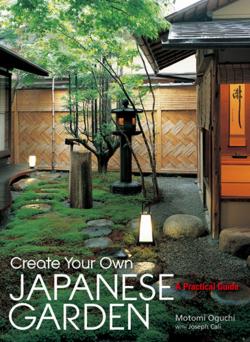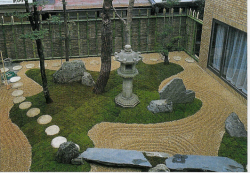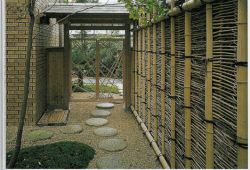Create Your Own Japanese Garden: A Practical Guide

By Motomi Oguchi and Joseph Cali
Kodansha International (2007)
ISBN 10:4770028040
Review by Sir Hugh Cortazzi
Oguchi is an experienced Japanese garden designer who has designed more than 400 gardens. In his introduction the author stresses that the history of Japanese gardens is linked to property size, architecture and the surroundings. He has been influenced by his attachments to the arts of tea, ikebana (flower arrangement) and bonsai. From the tea ceremony he learnt about wabi-sabi which he explains as being "to patiently strive for perfection, to leave pride and envy behind." From flower arrangement he learnt "the importance of and fleetingness of living things." Bonsai had taught him "much about the life of trees and the action of soil, water, and air upon them." It has also taught him "about creating naturalness from the unnatural."
He draws attention to the principles of garden design set out in the eleventh century Sakuteiki. He paraphrases these as being: 1. "According the natural conditions of the site, design each part of the garden tastefully, recalling how nature would present itself."
2. "Study the work of past masters and, considering the desires of your heart [or the customer's] create a new work, mindful of what has gone before."
3. "Recall the beautiful and tasteful scenes of nature, and by putting yourself into the work create a garden full of harmony and the feeling of such places."
He comments: "These guidelines have a clear direction - naturalness, tastefulness, and harmony." He goes on to list "formal elements and design devices" such as asymmetry and shakkei (borrowing scenery).
The book is divided into five chapters. Chapter one is devoted to "Approaches, Entrances and Front Gardens," chapter two to "Courtyard and Dry Landscape Gardens," chapter three to "Tea Gardens and Tree Gardens," chapter four to "Interior and Veranda Gardens in Commercial Spaces" and chapter five to "Special Touches, Restoration and Maintenance." The book contains much practical advice, for instance on how to make plaited bamboo fences, create a stone bridge and assemble and place stone lanterns.
As Oguchi is a Kyoto garden designer inevitably his advice and his designs are primarily for those living in a Japanese environment. While he does design gardens for western style houses in Japan this is a relatively minor element in his book. His gardens are mostly designed to go with Japanese houses with sight lines from a Japanese tatami room directly into a Japanese garden, although he does illustrate one or two gardens "tailored for viewing from above as well as ground level." (page 68)

Perhaps inevitably some of his gardens look contrived and artificial in comparison with historical gardens, but they may look more natural as they mature.

Anyone living in Britain who wants to build their own Japanese garden here would find this book of interest but it is not a full and sufficient guide for our needs. The book for instance stresses the important role of madake, the thick stemmed bamboo which grows so profusely round Kyoto but which cannot be grown in normal conditions in Britain. It also assumes that other types of bamboo can be easily found here and that the necessary stones and mature trees are readily available. Japanese gardens can be successfully developed in Britain as was demonstrated at the exhibition of photographs of Japanese gardens at the Japanese Embassy last year and for instance by the garden designed for the RHS show at Chelsea two years ago by the late Maureen Busby. But they are inevitably more difficult to design here than in Japan as they need to suit the British environment. They are also more difficult to build because of problems of finding the necessary materials and expertise. Anyone new to Japanese gardens needs to be aware of the importance of avoiding the "twee" and of thinking that a Japanese garden necessarily depends on a stone lantern and other artificial ornaments.
The simple answer in Britain if you are interested in Japanese gardens and hope one day to make your own is, of course, to join the Japan Garden Society and make contact with the specialist designers and suppliers who have made the society into such a flourishing organization and who produce the excellent quarterly journal Shakkei devoted to Japanese gardens and all that goes with them.
The hon, secretary of The Japan Garden Society, is Mrs Ann Dobson, Woodzend, Longdene Road, Haslemere, Surrey GU27 2PQ, (telephone: 0845-0944584, email; enquiries@jgd.org.uk

